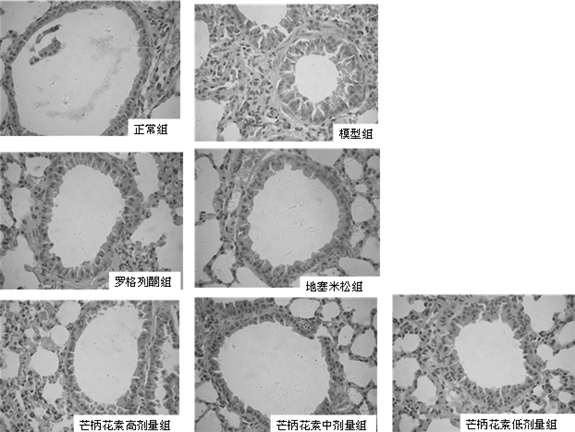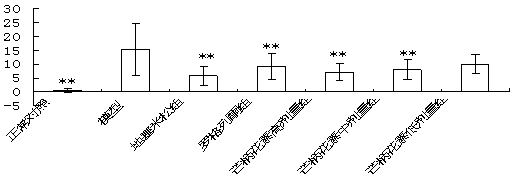Application of formononetin in preparing medicine for preventing and treating airway inflammation and asthma
A technology for formononetin and respiratory tract, which is applied to the application field of formononetin in the preparation of drugs for preventing and treating respiratory tract inflammation and asthma
- Summary
- Abstract
- Description
- Claims
- Application Information
AI Technical Summary
Problems solved by technology
Method used
Image
Examples
Embodiment 1
[0026] Improvement effect of embodiment 1 on experimental mouse lung pathology
[0027] Balb / C mice were randomly divided into 7 groups, 12 in each group: (1) blank control group; (2) model group; (3) dexamethasone (DM) group; (4) rosiglitazone group; ( 5) Formononetin high dose group; (6) Formononetin medium dose group; (7) Formononetin low dose group. Each group received subcutaneous injection of 0.1 mL of sensitization solution (0.2 ml of sensitization solution containing 0.1 mg of OVA and 0.02 mg of aluminum hydroxide) on day 1, intraperitoneal injection of 0.1 mL of sensitization solution per mouse, and subcutaneous injection of sensitization solution on day 8. 0.1mL / mouse, and 0.1mL / mouse intraperitoneal injection of sensitization solution. On the 14th to 27th day, the mice were placed in a transparent airtight container and challenged with 20mL nebulized inhalation (5% OVA), 20min each time, 1 times / day. After the 21st day, the formononetin low-dose group (0.01g·Kg -...
Embodiment 2
[0030] Effect of Example 2 on the level of inflammatory cells in mouse blood and tracheal lavage fluid
[0031] Balb / C mice were randomly divided into 7 groups, 12 in each group: (1) blank control group; (2) model group; (3) dexamethasone control group; (4) rosiglitazone control group; (5) Formononetin high dose group; (6) Formononetin medium dose group; (7) Formononetin low dose group. Each group received a subcutaneous injection of 0.1 mL of the sensitizing solution per mouse on the first day, an intraperitoneal injection of 0.1 mL per mouse, a subcutaneous injection of 0.1 mL of the sensitizing solution on the eighth day, and an intraperitoneal injection of 0.1 mL per mouse. On the 14th to 27th day, the mice were placed in a transparent airtight container and challenged by aerosol inhalation of 20 mL of nebulized solution, 20 min each time, once a day. After the 21st day, the formononetin low-dose group (0.01g·Kg -1 d - 1 ), formononetin middle dose group (0.02g·Kg -1 ...
Embodiment 3
[0037] Effect of Example 3 on the levels of inflammatory cytokines in airway lavage fluid
[0038] (1) The mice in the model and each medication group were taken, tracheotomy and intubation, alveolar lavage with 0.5mL PBS, repeated 3 times, and centrifuged at 1200r / min for 5min. The supernatant of the lavage fluid was stored in a -70°C refrigerator until testing. The levels of cytokines such as IL-4 and IL-7 were detected by ELISA method. The results showed that different doses of formononetin groups could reduce the contents of IL-17 and IL-4 in the airway lavage fluid, which was statistically significant compared with the model group (P image 3 shown.
[0039] (2) SP method was used for immunohistochemistry. Five high-power fields of view were taken from each slice of lung tissue, and the optical density values of each group were measured with Image Pro Plus 5.0.2 image analysis software. The results see that formononetin reduces the expression of IL-17 in lung tissue, ...
PUM
 Login to View More
Login to View More Abstract
Description
Claims
Application Information
 Login to View More
Login to View More - R&D
- Intellectual Property
- Life Sciences
- Materials
- Tech Scout
- Unparalleled Data Quality
- Higher Quality Content
- 60% Fewer Hallucinations
Browse by: Latest US Patents, China's latest patents, Technical Efficacy Thesaurus, Application Domain, Technology Topic, Popular Technical Reports.
© 2025 PatSnap. All rights reserved.Legal|Privacy policy|Modern Slavery Act Transparency Statement|Sitemap|About US| Contact US: help@patsnap.com



